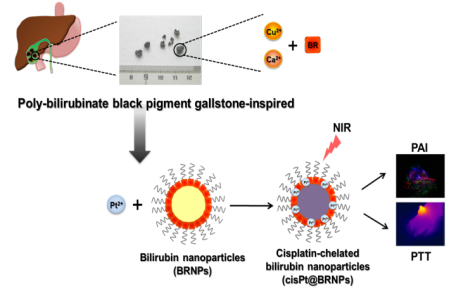As a research project of Global Research Laboratory funded by the National Research Foundation of Korea, Professor Sangyong Jon’s research team has developed a new class of photonic nanomaterials based on an endogenous bioactive compound, that enabled combined photoacoustic imaging and photothermal therapy of cancer in vivo. Bilirubin (BR), a bile pigment that exerts potent antioxidant and anti-inflammatory effects, is also a major constituent of black pigment gallstones found in bile ducts under certain pathological conditions. Inspired by the intrinsic metal-chelating power of BR found in gallstones, Jon’s group reported a cisplatin-chelated BR-based nanoparticle (cisPt@BRNP) for use as a new photonic nanomedicine for combined photoacoustic imaging and photothermal therapy of cancers. The cisPt@BRNPs were prepared by simply mixing cisplatin with BRNPs, yielding ~100-nm–size nanoparticles. Upon near infrared laser irradiation at 808 nm, cisPt@BRNPs generated considerable heat and induced clear death of cancer cells in vitro. Following intravenous injection into human colon cancer-bearing mice, cisPt@BRNPs allowed effective tumor visualization by photoacoustic imaging and remarkable antitumor efficacy by photothermal therapy, suggesting their potential for use as a new photonic nanomedicine for cancer therapy. This work was recently published in Angew. Chem. Int. Ed. in October, 2017.

Prof. Sangyong Jon (Department of Biological Sciences)
Homepage: http://www.bionanolab.co.kr
E-mail: syjon@kaist.ac.kr






